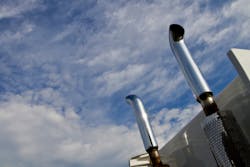PHILADELPHIA. The goals for the next round of federal truck fuel efficiency requirements will be achievable, says the head of the country’s largest truck maker—he’s just not sure yet what the solutions are going to be. And all bets are off if the EPA’s Phase 2 greenhouse gas (GHG) reduction program strays from the preliminary standards proposed earlier this year, Daimler Trucks North America President and CEO Martin Daum told trucking media representatives during a roundtable discussion here.
That proposed target is a 24% improvement in heavy-duty fuel efficiency by 2027, which Daum concedes is “a lot.” The good news is the company has “ideas for the first steps,” but where those steps will lead is to be determined.
“You can’t have this for nothing. You have to invest and you have to start today thinking about how,” Daum said. “I’m confident we can reach it, but I don’t know how.”
While DTNA is generally supportive of the program’s goals, Daum objected to a possible engine-only standard separate from the vehicle requirements.
“I’ve never seen an engine alone running down the road,” he quipped. “We need all the pieces to fit together to optimize [fuel efficiency]. But the higher the engine standard, the less room we have for optimization.”
He does credit EPA with being “fully aware of the complexity” of the rulemaking, and for working with the industry as well as with environmental advocates and state and local air quality agencies to develop the plan.
DTNA also would like to see a single national standard, but the real concern is for the possible development of a new, lower NOx regulation. His concern is that the GHG rule will be finalized and manufacturers will begin to work toward meeting the requirements, and then EPA will set another NOx limit. And that will cause an industry "disruption" similar to 2006.
“Don’t touch NOx,” Daum said. “Our entire positive-challenge outlook is off, the moment we get a NOx rule. A NOx rule won’t benefit our customers, it will just make trucks more expensive. This would be very short sighted.”
Indeed, some 3 billion gallons of fuel are wasted due to congestion each year, outweighing many times over the projected fuel savings for the Phase 2 rule, according to DTNA. So Daum suggests that policy makers should focus first on relieving traffic bottlenecks, which account for 40% of that wasted fuel.
Sean Waters, DTNA director of compliance and regulatory affairs, added that’s he’s “optimistic” the EPA leadership will listen to the recommendations of the agency engineers rather than be swayed by emotional appeals and political considerations.
He suggested that both the 24% improvement and the 2027 timeline likely will be features of the final rule. But he admitted to being somewhat “worried” about the date's being moved up due to a “campaign of sorts” that generated some 150,000 “generic” comments from individuals calling for a speedier implementation.
“We don’t think moving the 2027 standards to 2024 is possible because we don’t have time to invent the technology,” Waters said. “It’s hard to speculate what they’re going to do, but EPA and NHTSA are data-driven organizations—and the four truck OEMs have jointly stated that it’s not possible.”
As to NOx, Waters too explained that there are “far better” and “less disruptive” solutions for improving air quality other than imposing a new standard on trucks, although California specifically is looking for tighter regulations
“NOx and CO2 are inextricably intertwined in the engine—that’s a physics problem we can’t overcome—but if you use less fuel you will also end up with less NOx,” Waters said. “The number one thing California could do would be to accelerate fleet equipment turnover. The vast majority of trucking companies are still using pre-EPA10 trucks and, given the NOx reduction since 2010, getting new trucks on the road would the fastest way to achieve better air quality standards.”
About the Author
Kevin Jones 1
Editor
Kevin has served as editor-in-chief of Trailer/Body Builders magazine since 2017—just the third editor in the magazine’s 60 years. He is also editorial director for Endeavor Business Media’s Commercial Vehicle group, which includes FleetOwner, Bulk Transporter, Refrigerated Transporter, American Trucker, and Fleet Maintenance magazines and websites.

